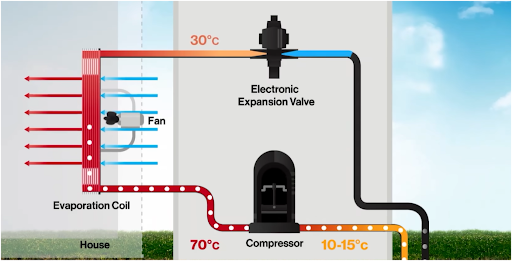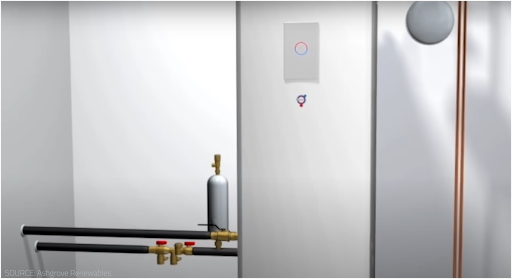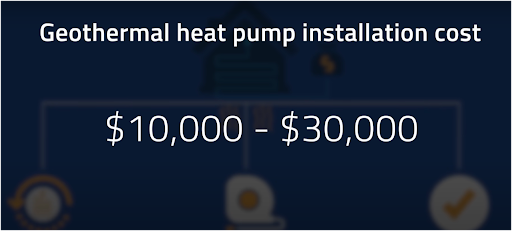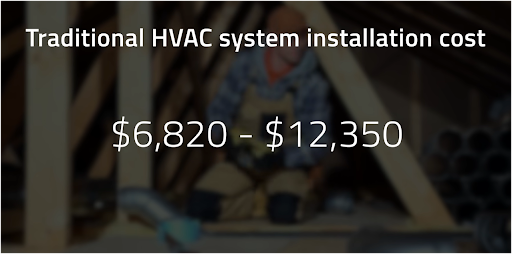I used to think geothermal heating was just for off-grid cabins or cutting-edge eco homes. But after analyzing the details, I realized it’s more practical and affordable than most people think. Especially when it comes to monthly bills. In this post, I’ll share what I discovered about geothermal systems including how much does geothermal heating cost per month? This blog will cover from installation costs to what you might expect on your monthly energy bill. If you’re curious about energy savings and system lifespan this guide should help. This guide will help you understand, how it stacks up to traditional HVAC.
Understanding Geothermal Heating and Cooling
 Image Credit- Undecided with Matt Ferrell
Image Credit- Undecided with Matt Ferrell
Geothermal systems tap into the steady temperature underground to regulate your home’s climate. Unlike standard systems that fight against outdoor air temperatures, geothermal uses underground loops. Geothermal uses a heat pump to move heat in or out of your home, depending on the season.
In winter, it pulls heat from the earth into your house. In summer, it dumps indoor heat back into the ground. The result? Efficient, low-cost heating and cooling, year-round.
How Much Does Geothermal Heating Cost Per Month?
The average monthly cost for geothermal heating typically lands between $30 and $75. The cost also depending on your home’s size, insulation, your local climate, and electricity rates.
To put this into perspective, my winter heating bills hovered around $120 with a gas furnace. Switching to geothermal, that dropped to about $50 a month. That’s a serious difference.
Here’s a quick snapshot:
| Home Size | Traditional HVAC | Geothermal System |
| 1500 sq ft | $100/month | $40–$60/month |
| 2500 sq ft | $150/month | $60–$80/month |
Your mileage may vary, of course, but many homeowners see monthly savings of 30%–60%.
What Influences Your Monthly Geothermal Heating Costs?
 Image Credit- Undecided with Matt Ferrell
Image Credit- Undecided with Matt Ferrell
Several factors come into play when figuring out your expected monthly cost:
- Square Footage: Larger homes need more energy.
- Insulation Quality: Well-sealed homes retain temperature better.
- Thermostat Habits: Keeping temps steady saves energy.
- Climate: Cold regions may require more electricity.
- Local Electricity Rates: Since the system runs on power, rates matter.
All of these influence how much you’ll pay each month. Still, even in colder areas, geothermal systems tend to outperform traditional setups in efficiency.
Upfront Costs vs. Long-Term Savings
 Image Credit- Undecided with Matt Ferrell
Image Credit- Undecided with Matt Ferrell
The sticker shock of a geothermal installation is real. Depending on your setup (horizontal or vertical loops), prices can range from $18,000 to $30,000. But here’s why I still made the leap:
- 30% federal tax credit off the total cost
- Utility rebates up to $3,000
- Monthly savings of $50–$100
Over time, that investment pays off. Many homeowners break even in 7 to 10 years, especially with rising energy costs.
Also worth noting: geothermal systems last a long time. The loop system can easily go 50 years, and the heat pump? Around 20–25 years with basic maintenance.
Efficiency That Pays Off
If saving money wasn’t enough, geothermal systems also enhance energy efficiency. They operate at 300%–500 % efficiency, meaning they deliver 3 to 5 units of heat for every unit of electricity used. That’s tough to beat.
Plus, there’s no combustion involved, making these systems cleaner and safer. There’s no risk of carbon monoxide, and the system runs nearly silently.
Comparing Geothermal With Traditional HVAC
 Image Credit- Undecided with Matt Ferrell
Image Credit- Undecided with Matt Ferrell
Still trying to decide if it’s the right move? Here’s a side-by-side:
| Feature | Traditional HVAC | Geothermal System |
| Monthly Cost | $100–$250 | $30–$75 |
| Maintenance | Moderate to high | Low |
| Lifespan | 10–15 years | 25–50 years |
| Efficiency | 80–90% | 300–500% (COP 3–5) |
| Emissions | Higher | Lower |
Geothermal clearly wins on longevity, efficiency, and monthly savings.
Tax Credits and Financial Perks
Don’t overlook the financial help available. In 2025, the federal tax credit covers 30% of the total system cost. Some states tack on more rebates, and certain utility companies offer local incentives.
In my case, federal and state incentives knocked about $9,000 off the total. Combine that with lower monthly bills, and the upgrade started making real financial sense.
FAQs
1. Is Geothermal Heating Expensive To Run?
Not at all! After my system was installed, I was honestly shocked at how low my bills dropped. I’m now paying between $30–$75 a month for heating and cooling—way less than what my old furnace and AC ever cost me.
2. How Much Does Geothermal Heating Cost?
Okay, yeah—that part stings a bit. My system cost around $18,000–$30,000 before incentives. But here’s the thing: tax credits and rebates cut that down significantly. When I stacked that up against the constant repair bills from my old HVAC system, switching became a total no-brainer.
3. Is geothermal really better than AC?
100%. My house stays evenly cool during the hottest months—no hot spots, no noisy outdoor unit, and no more sticker shock from summer electric bills. It genuinely feels like my home just stays at the perfect temperature without the effort.
4. What are the disadvantages of geothermal?
The biggest drawback is definitely the upfront cost and the space needed for installation, especially if you’re limited on yard area. But considering the savings, comfort, and lifespan? I’d make the same choice again in a heartbeat.
Final Thoughts: How Much Does Geothermal Heating Cost Per Month?
So, to wrap it up, how much does geothermal heating cost per month? It’s in the $30 to $75 range for most homeowners. That’s a big improvement over traditional systems that often double that amount or more. Between energy savings, rebates, and long-term durability, geothermal heating is one of the smartest choices I’ve made for my home. If you’re planning to stay in your house for a while and want lower utility bills and better comfort, it’s well worth a look.



